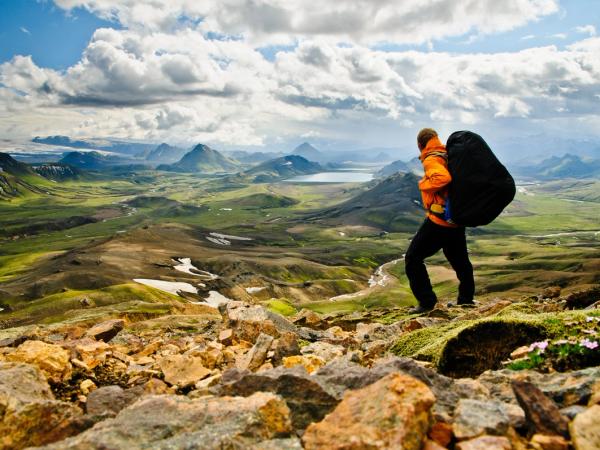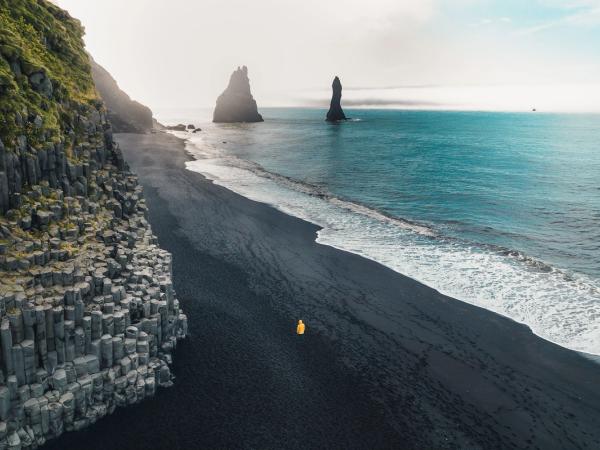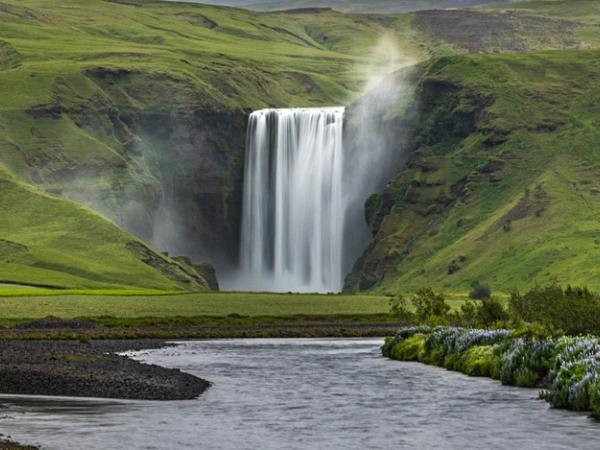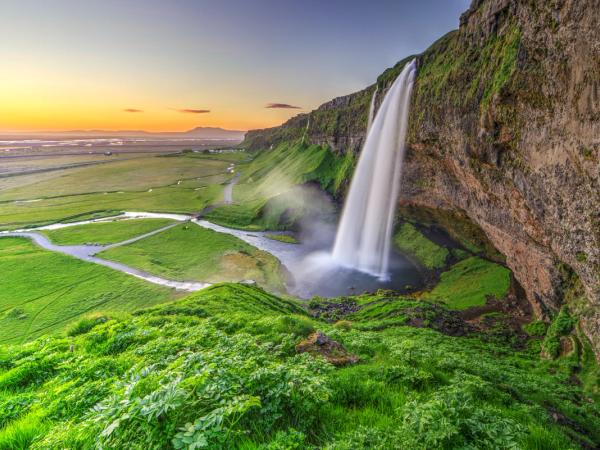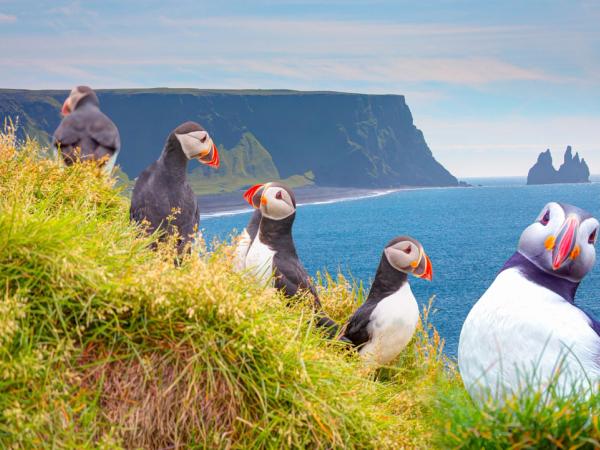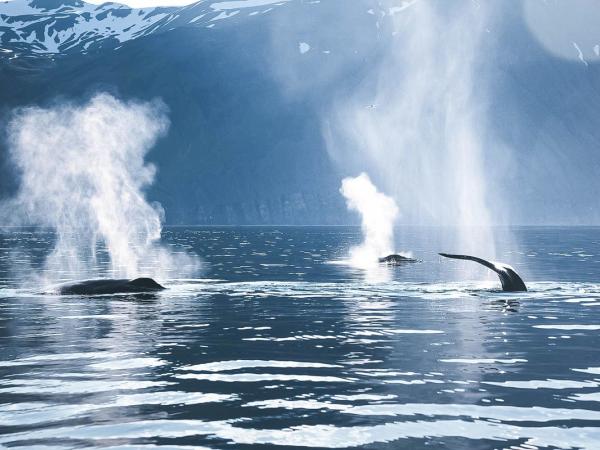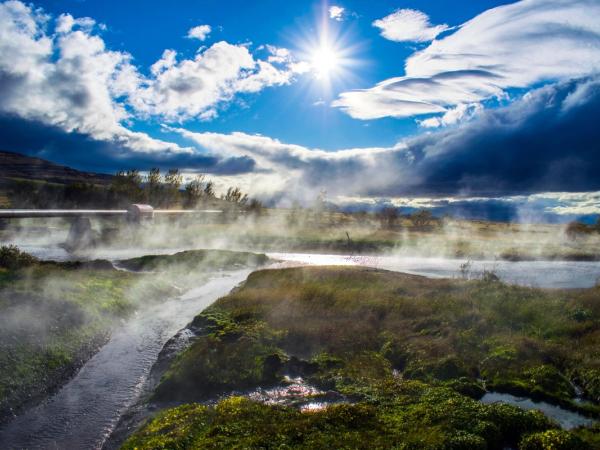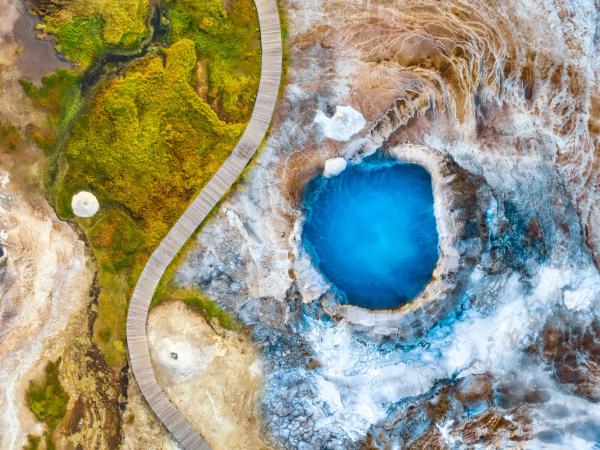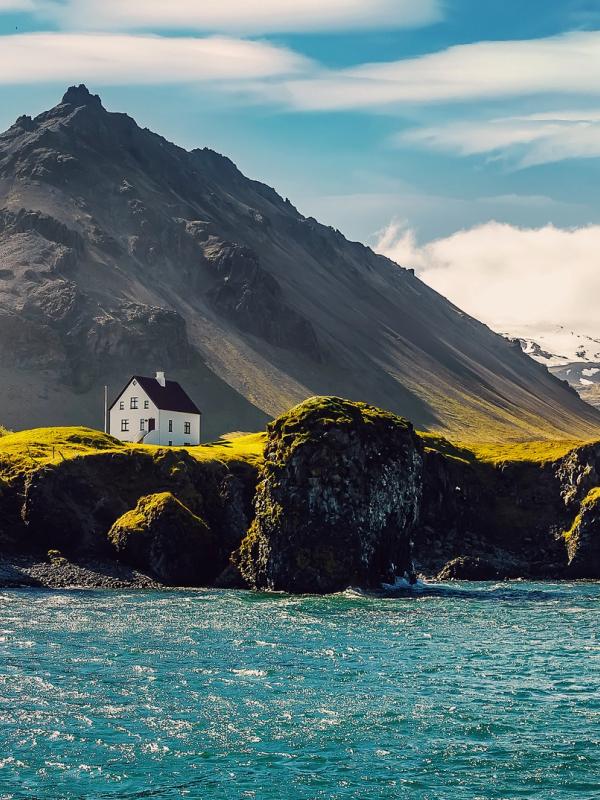
Iceland in Summer: The Best Things to Do and See in 2025
Long days, burning golden hours, coffee that somehow tastes better when you drink it outside a campervan at 11pm. Summer in Iceland is when the whole country is open for business, when the sun just drifts along the horizon at night, when the weather is clear and stable, and there’s endless opportunity for adventure.
This isn’t a guide about packing lists or the warmest month (spoiler: there isn’t one). It’s for the traveler who’s already planning, already circling names on the map. Below, we’ve gathered the most unforgettable ways to experience Iceland in summer – routes to drive, cliffs to climb, pools to sink into, and roads that skirt past mountains, glaciers, and volcanoes.
Hike in the Highlands
The Icelandic Highlands only open up for a few short months each summer, revealing a volcanic wilderness that feels a world apart from the Ring Road. Driving into the interior, you leave behind paved roads and enter a land of shifting light, multicoloured mountains, black sand deserts, and steaming vents.
Landmannalaugar is the classic destination, known for its swirling rhyolite hills and its steaming geothermal river, where you can soak after a hike. Trails lead in every direction, from quick loops to the full Laugavegur Trail, which stretches 55km to Thórsmörk. That green, glacier-carved valley is another highland favourite — quieter than the South Coast but no less spectacular, with moss-covered hills and braided rivers winding into the distance.
Then there’s the Kjölur Route, home to the geothermal mountains of Kerlingarfjöll, and Hveravellir, a remote geothermal oasis surrounded by lava fields and snow-capped peaks. Here, you can bathe in a natural hot spring while the wind rushes through endless open space.
Reaching these places requires preparation. You’ll need a 4x4 vehicle, a careful eye on road conditions, and ideally, a flexible schedule in case of bad weather or rivers flooded with rain interrupt any travel plans. But the reward is a glimpse of Iceland that few travelers see — vast, elemental, and timeless.
Drive the South Coast
Iceland’s South Coast is summer road-tripping at its best. This stretch of coast delivers so many of the country’s iconic landscapes that it almost feels unfair. You can walk behind waterfalls, hike to glacier tongues, picnic on black sand beaches, and watch icebergs drift out to sea — all within a day’s drive.
Seljalandsfoss is the first big waterfall most travelers encounter, its narrow cascade tumbling from a mossy cliff into a pool below. A slippery path leads behind the falls for a view through the mist. Just down the road, Skógafoss thunders off a higher drop, sending up rainbows in the spray. You can climb a steep staircase to see it from above, where hiking trails extend into the Highlands.
Further east, Reynisfjara beach stuns with its black sand, crashing waves, and basalt sea stacks. The beach is as moody as it is beautiful, with sneaker waves that demand respect. Then, marooned in the far southeast corner of Iceland is Jökulsárlón, where chunks of glacier float through a luminous lagoon before washing up on Diamond Beach.
In summer, you can visit all these places late at night under glowing skies. There’s no need to rush — in fact the later you arrive, the less crowded it’ll be.
Chase the Midnight Sun
From late May to early August, darkness never fully arrives in Iceland thanks to the Midnight Sun. The sun hovers just above the horizon, casting a lingering, low light that turns everything it touches to gold. Shadows stretch, clouds glow from below, and the sky fades through every shade of pink and blue.
It’s a strange, beautiful time to be outside. You can set out on a hike after dinner, take photographs in perfect light at 2am, or visit popular sites when no one else is around. On the quiet roads of Snæfellsnes, mountain silhouettes sharpen against the sea under a sky that never darkens. In the Highlands, the pastel light softens every ridge and ravine, revealing color and texture you’d miss in the midday glare.
You’ll want an eye mask for sleep, but also don’t fight the shift in rhythm – you’ll likely find you have lots of extra energy, so let the light pull you out late. There’s a quiet thrill in making coffee at midnight while the sun still hovers over the ocean.
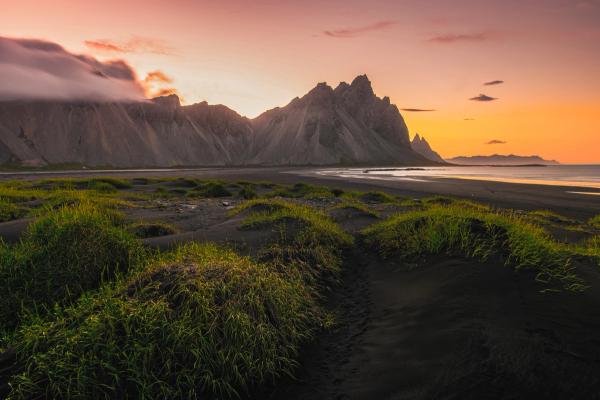
Spot Whales and Puffins
Summer is Iceland’s peak wildlife season, and you don’t need to travel far to find it. Whale-watching tours depart from harbors across the country, with the best sightings from June to August. In Húsavík – Iceland’s whale-watching capital – boats slip into Skjálfandi Bay, where humpbacks breach and minke whales glide through the waves. Orcas and even the occasional blue whale have been spotted here, too. If you're short on time, tours from Reykjavík’s Old Harbour offer surprisingly good chances of seeing marine life in Faxaflói Bay.
For puffins, look to the cliffs. Látrabjarg in the Westfjords is one of the most reliable places to see them up close, with thousands nesting on the narrow ledges. The birds, mostly unbothered by human presence, often come within arm’s reach. On the South Coast, Dyrhólaey offers sweeping views and accessible colonies right off the Ring Road. Puffins are most active between mid-May and mid-August; visit at sunrise or late evening for soft light and fewer crowds.
Soak in Hot Springs
Few things cut through travel fatigue like stepping into naturally heated water. In Iceland, hot springs are part of the rhythm of the landscape – steaming beside hiking trails, tucked into lava fields, or just off a quiet fjord road. Summer makes it easier to reach the wilder ones when remote tracks are open and the weather is more forgiving.
Near Hveragerði, Reykjadalur (Steam Valley) is a popular choice. A 45-minute uphill walk leads to a warm river that flows through the hills, where bathers settle into the streambed and let the heat soak in. It can get busy, but head out early or late for a quieter soak. In the Highlands, Hveravellir is harder to reach but worth it: a steaming plateau with one clear, mineral-rich pool overlooking the vast interior. Then there are the countless hot springs in the Westfjords, where you’ll often have a hot pot and stunning views just for yourself.
Not every spring is safe for bathing. Some are far too hot or unstable, so always check signage and test the water before getting in. And since many are wild and unmonitored, come prepared: bring a towel, pack out what you bring in, and leave the place as you found it.
Explore the Westfjords
Fewer than 10% of travelers make it to the Westfjords—a surprising number, given how much this remote corner of Iceland quietly offers. In summer, the snow lifts from the mountain passes, revealing a tangle of narrow roads, deep fjords, and a coastline that feels almost forgotten.
First stops often include Dynjandi, a wide, layered waterfall that spills down a cliff like a bridal train. It’s just a short walk from the parking lot, but its scale catches you off guard. Further south, Rauðisandur stretches out in shifting tones of gold and red, its color changing with the light. On clear days, you can see Snæfellsjökull gleaming across the water. Near the village of Drangsnes, geothermal tubs sit right at the edge of the sea, where locals soak alongside travelers as fishing boats pass quietly offshore.
The roads here are often unpaved, sometimes steep. Drive slowly. Plan ahead for fuel and food. But above all, leave room in your schedule. The Westfjords reward unhurried travel—not just for the landscapes, but for the space they give you to take it all in.
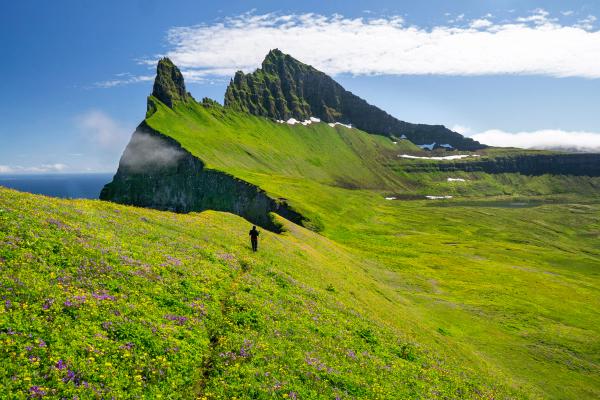
Go Kayaking on the Lagoons
There’s something surreal about paddling past ancient ice. In Iceland’s southeast, several glacial lagoons offer the chance to kayak among towering bergs — quiet, eerie, and unforgettable. Fjallsárlón is a favourite for its up-close views of a dramatic ice tongue, while neighbouring Jökulsárlón offers wider waters and floating giants that groan and crack as they melt.
Heinabergslón is one of the least-known lagoons, where you can land kayaks on the icebergs to go clambering across with your guide. On the South Coast, Sólheimajökull lets you paddle right up to the glacier, with volcanic ash streaking the ice in shades of grey and black.
Most kayak tours run from June to September and provide all the gear. Dress in layers, wear warm socks, and prepare to get a little wet.
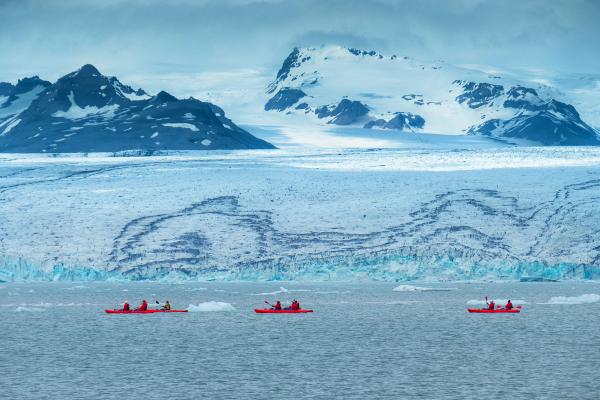
Visit Iceland’s Remote Islands
For a different perspective on Iceland – one that trades ring roads for sea crossings – set your sights offshore. Scattered around the coast, these remote islands offer a quieter, slower version of the country, best explored in summer when ferries run regularly and skies stay light.
In Breiðafjörður Bay, Flatey is a small, car-free island known for its painted houses, nesting birds, and unhurried rhythm. A handful of permanent residents stay year-round, but summer brings visitors arriving by ferry from Stykkishólmur or Brjánslækur in the Westfjords for a few hours or overnight stays. Time moves differently here, measured by tides, birdsong, and the occasional church bell.
Further north, Hrísey sits in Eyjafjörður and lives up to its nickname: The Pearl of the North. It’s a haven for birdwatchers and walkers, with easy trails, quiet gardens, and big views over the fjord. Ferries from Árskógssandur run several times a day.
Then there’s Grímsey, perched just above the Arctic Circle. It’s a three-hour ferry from Dalvík, but the reward is a landscape marked by puffins, painted polar lines, and the rare chance to stand in the Arctic without leaving Iceland.
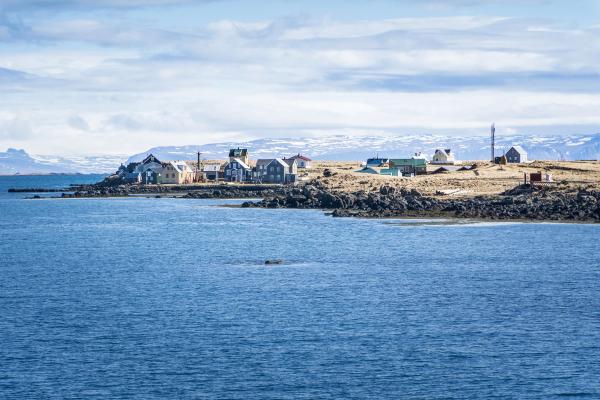
Undertake a Multi-Day Trek
If you’re looking to go beyond the roadside views, summer is the time to walk deep into Iceland’s interior. Multi-day treks here aren’t just about distance – they’re about watching the land change under your feet and immersing yourself in Iceland’s wild side. Black sand plains give way to mossy valleys, steam rises from the hills, and there’s often no sign of a road for days.
The Laugavegur Trail is Iceland’s most iconic route for good reason. It runs from the colorful rhyolite slopes of Landmannalaugar to the glacier-carved landscapes of Thórsmörk, crossing hot springs, lava fields, and snow patches along the way. Most hikers complete it in 3 to 4 days, staying in mountain huts or camping beneath the midnight sun.
For something more remote, the Hornstrandir Nature Reserve in the Westfjords offers true wilderness. There are no roads, no permanent residents – just arctic foxes, sea cliffs, and quiet trails that hug the edge of the map.
Want more ideas? We’ve rounded up our favourite routes – from remote wilderness routes to iconic long-distance trails — in our Best Multi-Day Hikes in Iceland guide.
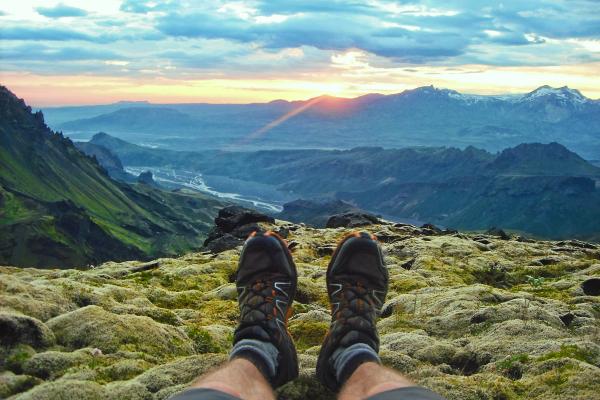
Conclusion
Summer in Iceland means long light, open roads, and space to explore. It’s waterfalls in the evening mist, puffins on the cliffs, and coffee brewed outside as the day stretches on. Whether you’re chasing glaciers or just looking for a quiet place to stop, this is the season when the country opens up and invites you in.


